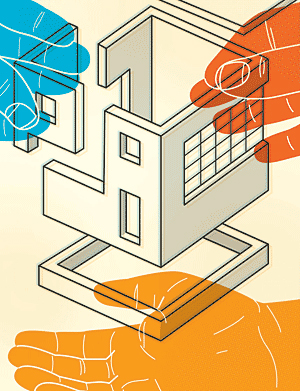
Fostering collaboration
Collaboration can range from a casual comment over the phone or a napkin sketch that triggers new ideas to a formal work session that includes well-choreographed brainstorming toward creation of various alternative solutions to vexing problems. Scott Simpson, principal and senior director at the Cambridge, Massachusetts, office of KlingStubbins, elaborates: “Collaboration is an attitude more than a process. Participants assume that each member of the team has something valuable to offer, and that by using many brains synergistically rather than working in ‘silos,’ overall outcomes will be dramatically improved. In a collaborative effort, it is understood that different points of view add richness and depth to the project, but this means that ego must take a back seat.” The great caveat, of course, is that the work is indeed amenable to a team approach and that an individual could not better or more efficiently execute it. It must be recognized that some challenges are best met by one good performer.
A productive, collaborative work session requires talented people who are empowered to make decisions on behalf of their firms and who are unafraid to push disciplinary boundaries. Recounting one such session, David Altenhofen, AIA, technical design principal at RMJM Hillier, comments that each member must feel free to present ideas even if they are out of the participant’s area of expertise; for example, when a structural engineer makes aesthetic suggestions, or when the builder makes suggestions regarding plumbing. Integrated designs cannot evolve successfully without the participation of all relevant disciplines.
Attitude is critically important. Everyone on a team has an obligation to strive for the group’s success. Roger Goldstein, FAIA, principal at Goody Clancy, believes that attitude has more to do with building trust than anything else. He says, “Being respectful of peoples’ contributions, even if you disagree or think some ideas are not worthwhile, helps on the trust dimension,” and inevitably will reinforce the habit of vocal contribution.
Although there are no formulae for working well together, collaborative performance can be cultivated in a number of ways. Richard Hackman, a Harvard professor and guru of successful group process, suggests that having an ennobling theme for the work will increase the likelihood of the group’s effectiveness. A lofty, overarching objective “energizes team members, orients their attention and action, and engages their talents.” In architecture, this translates generally to understanding that architecture is a profession and as such, no matter how mundane a project may seem, the work is transcendent because it provides a professional service, which is truly distinctive in society. It translates specifically to doing excellent design work as defined by a firm’s mission and project-specific circumstances. Creatively and cleverly framed design challenges, proffered at every phase of a project, are intrinsically motivating and lead to higher productivity and quality.

Post a comment to this article
Report Abusive Comment